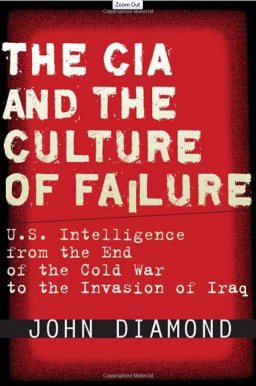John Diamond
Stanford, California: Stanford University Press, 2008, h/b.
No price is stated but it’s around $30 on-line.
In The Guardian on 4 March 2009 William Dalrymple wrote:
‘Eight years of neocon foreign policies have been a spectacular disaster for American interests in the Islamic world, leading to the advance of Hamas and Hezbollah, the wreckage of Iraq, with more than two million external refugees and the ethnic cleansing of its Christian population, the rise of Iran as a major regional power, and now the implosion of Afghanistan and Pakistan, prob-ably the most dangerous development of all.’
But for whom has this been a disaster? Or for which interests? All manner of people within the US have done very nicely out of the trashing of Iraq. Billions of dollars of tax dollars in ‘aid’ have been stolen, as well as all the ‘legitimate’ profits made by US corporations servicing the new semi-privatised US military.(1) In any case, going into a situation where they have some notional or actual ‘interest’, killing lots of people, wrecking the country/area concerned and making things worse isn’t exactly new where the Americans are concerned. (Think of Vietnam and Cambodia, for example, or Colombia today; or Central America in the 1980s.)
This happens because the American system as constructed since 1945 needs enemies. It needs ‘threats’. If the Pentagon and the corporations and politicians feeding off it are to continue to receive 50% of federal tax dollars there needs to be a plausible threat or threats with which to justify that spending. And so, as the Cold War ended, right on cue, up stepped ‘terrorism’ which had been kept warm since the late 1970s when it was put together by anti-communists seeking ways of keeping the Soviet ‘threat’ alive under conditions of détente (the world–terror–sponsored–by–the–KGB thesis) and by Israeli propagandists looking for sticks with which to beat the Palestinians. And since then this ‘threat’ has worked a treat, ramifying and multiplying into an new, vast, hydra-headed, near-invisible, global threat, justifying vast new expenditure and military and intelligence expansion all over the world.
But threat generation isn’t enough in itself; the threat also has to be legitimised; and, despite the DIA and Air Force and Naval intelligence, at the apex of the legitimising process remains the CIA. The CIA’s intelligence estimation process is therefore the key area of contest for the military-industrial-complex: no threat, no dollars. This puts the CIA’s analysts under acute pressure. This large (500 + pages), nicely produced and thoroughly documented book is a history of the most important of those recent contests, from the debate in the 1970s over the scale of the Soviet missile ‘threat’ through to the invasion of Iraq.(2)
Essentially, the CIA has been in an impossible position. Tasked with surveilling the entire planet, which can’t done, even with satellites, it was constantly attacked by the m-i-c and its allies for getting it wrong when it failed to predict something (e.g. the collapse of the Soviet empire) and for ‘putting America at risk’ if its estimates of the ‘threat’ are too low for corporate profitability. In this cleft stick the Agency has tacked up and down, trying to retain some grasp on reality against the delusions and desires of the military and the right, without going so far offside that it became marginalised or risked being replaced. This process reached its most recent climax when the Agency buckled under the pressure from the Republican administration to confirm that Iraq had WMDs and announced, against all the available evidence bar that of one dodgy defector, ironically code-named ‘Curveball’, that Iraq probably did. And ‘probably’ was all that was required.
The author isn’t a radical and would certainly not accept as true anything resembling my description above of the processes involved. He makes some of the fudges made by mainstream writers on US intelligence: for example he skates over the horrors in Central America in the 1980s and omits the central fact that the Attorney General gave the CIA permission to ignore drug trafficking if the trafficker gave a donation to the war against Nicaragua. (In its untouchability, this event is acquiring a status akin to that of the assassinations of the 1960s.) But he is a good researcher, has talked to many senior figures (mostly, of course, those who opposed the war, who have opposed the military-industrial-complex, or who are boosters for the CIA). He has a fascinating tale to tell, particularly in chapter 6, ‘Known unknowns’, in which he traces the bureaucratic manoeuvres which enabled the Rumsfeld-Cheney team to produce the rationale for the attack on Iraq despite the lack of evidence of Iraqi weapons or intent, summarised in the elegant phrase ‘absence of evidence is not evidence of absence’.
It says something about the times we are living through that the author manages to make the CIA’s analysts seem like paragons of virtue and rationality.
Notes
- See, for example, Anthony Holden, ‘How war is big business: George W Bush’s allies did very well from conflict’, Daily Telegraph, 6 March 2009.
- The missile ‘threat’ refers to the Team B episode, in which the ‘hawks’ were allowed access to the CIA’s files in order to more thoroughly rubbish the CIA’s estimates.
